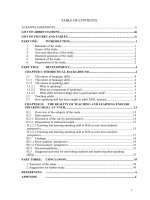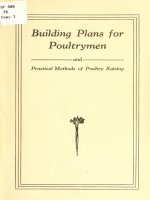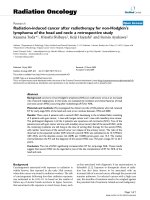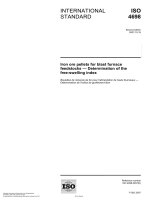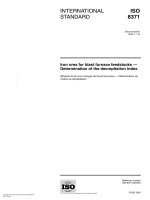BS EN 205 2003 adhesives wood adhesives for non structural applications determination of tensile shear strength of lap joints
Bạn đang xem bản rút gọn của tài liệu. Xem và tải ngay bản đầy đủ của tài liệu tại đây (150.51 KB, 16 trang )
BRITISH STANDARD
BS EN
205:2003
Adhesives — Wood
adhesives for
non-structural
applications —
Determination of
tensile shear strength
of lap joints
The European Standard EN 205:2003 has the status of a
British Standard
ICS 83.180
12&23<,1*:,7+287%6,3(50,66,21(;&(37$63(50,77('%<&23<5,*+7/$:
BS EN 205:2003
This British Standard was
published under the authority
of the Standards Policy and
Strategy Committee on
3 April 2003
© BSI 3 April 2003
ISBN 0 580 41531 7
National foreword
This British Standard is the official English language version of EN 205:2003.
It supersedes BS EN 205:1991 which is withdrawn.
The UK participation in its preparation was entrusted to Technical Committee
PRI/52, Adhesives, which has the responsibility to:
A list of organizations represented on this committee can be obtained on
request to its secretary.
Cross-references
The British Standards which implement international or European
publications referred to in this document may be found in the BSI Catalogue
under the section entitled “International Standards Correspondence Index”, or
by using the “Search” facility of the BSI Electronic Catalogue or of British
Standards Online.
This publication does not purport to include all the necessary provisions of a
contract. Users are responsible for its correct application.
Compliance with a British Standard does not of itself confer immunity
from legal obligations.
— aid enquirers to understand the text;
— present to the responsible international/European committee any
enquiries on the interpretation, or proposals for change, and keep the
UK interests informed;
— monitor related international and European developments and
promulgate them in the UK.
Summary of pages
This document comprises a front cover, an inside front cover, the EN title page,
pages 2 to 13 and a back cover.
The BSI copyright date displayed in this document indicates when the
document was last issued.
Amendments issued since publication
Amd. No. Date Comments
EUROPEAN STANDARD
NORME EUROPÉENNE
EUROPÄISCHE NORM
EN 205
March 2003
ICS 83.180 Supersedes EN 205:1991
English version
Adhesives - Wood adhesives for non-structural applications -
Determination of tensile shear strength of lap joints .
Adhésifs - Colles pour bois à usages non structuraux -
Détermination du pouvoir adhésif des collages
longitudinaux par l'essai de cisaillement
Klebstoffe - Holzklebstoffe für nichttragende Anwendungen
- Bestimmung der Klebfestigkeit von Längsklebungen im
Zugversuch
This European Standard was approved by CEN on 21 November 2002.
CEN members are bound to comply with the CEN/CENELEC Internal Regulations which stipulate the conditions for giving this European
Standard the status of a national standard without any alteration. Up-to-date lists and bibliographical references concerning such national
standards may be obtained on application to the Management Centre or to any CEN member.
This European Standard exists in three official versions (English, French, German). A version in any other language made by translation
under the responsibility of a CEN member into its own language and notified to the Management Centre has the same status as the official
versions.
CEN members are the national standards bodies of Austria, Belgium, Czech Republic, Denmark, Finland, France, Germany, Greece,
Hungary, Iceland, Ireland, Italy, Luxembourg, Malta, Netherlands, Norway, Portugal, Slovakia, Spain, Sweden, Switzerland and United
Kingdom.
EUROPEAN COMMITTEE FOR STANDARDIZATION
COMITÉ EUROPÉEN DE NORMALISATION
EUROPÄISCHES KOMITEE FÜR NORMUNG
Management Centre: rue de Stassart, 36 B-1050 Brussels
© 2003 CEN All rights of exploitation in any form and by any means reserved
worldwide for CEN national Members.
Ref. No. EN 205:2003 E
EN 205:2003 (E)
2
Contents
page
Foreword 3
Introduction 4
1 Scope 5
2 Normative references 5
3 Terms and definitions 5
4 Principle 5
5 Safety 5
6 Apparatus 6
7 Procedure 6
7.1 Preparation of bonded assemblies 6
7.2 Preparation of test pieces 8
7.3 Number of test pieces 10
7.4 Treatment prior to tensile shear testing 10
7.5 Tensile shear test 10
8 Expression of results 10
9 Test report 10
Annex A
(informative)
Single lap joint test pieces 12
Bibliography 13
EN 205:2003 (E)
3
Foreword
This document (EN 205:2003) has been prepared by Technical Committee CEN/TC 193, "Adhesives", the
secretariat of which is held by AENOR.
This European Standard shall be given the status of a national standard, either by publication of an identical text or
by endorsement, at the latest by September 2003, and conflicting national standards shall be withdrawn at the
latest by September 2003.
This document supersedes EN 205:1991.
Annex A is informative.
According to the CEN/CENELEC Internal Regulations, the national standards organizations of the following
countries are bound to implement this European Standard: Austria, Belgium, Czech Republic, Denmark, Finland,
France, Germany, Greece, Hungary, Iceland, Ireland, Italy, Luxembourg, Malta, Netherlands, Norway, Portugal,
Slovakia, Spain, Sweden, Switzerland and the United Kingdom.
EN 205:2003 (E)
4
Introduction
European Standards giving a common classification with respect to durability classes for wood adhesives will allow
considerable improvement in consumer protection in any future product liability system with regard to properties
guaranteed by the adhesive manufacturer.
The methods described in this standard are suitable for the following and other applications:
- assessing the usability and quality of adhesives for wood and derived timber products;
- classifying these adhesives into the durability classes D1 to D4 of EN 204 (thermoplastic adhesives) and C1 to C4
of EN 12765 (thermosetting adhesives);
- assessing effects on the bond strength resulting from the bonding conditions chosen, the various conditioning
sequences and the treatment of the test pieces before and after bonding;
EN 205:2003 (E)
5
1 Scope
This European Standard describes tests for adhesives for wood and derived timber products for the assessment of
their resistance to hot and cold water. It can be used for the assessment of the strength of bonds with a thin or thick
bond-line. It does not apply to adhesives for structural use or to the manufacture of particle boards, fibreboard's
and plywood. It does not replace tests on finished products.
2 Normative references
This European Standard incorporates by dated or undated reference, provisions from other publications. These
normative references are cited at the appropriate places in the text and the publications are listed hereafter. For
dated references, subsequent amendments to or revisions of any of these publications apply to this European
Standard only when incorporated in it by amendment or revision. For undated references the latest edition of the
publication referred to applies (including amendments).
EN 204,
Classification of thermoplastic wood adhesives for non-structural applications.
EN 923:1998,
Adhesives —Terms and definitions
EN 12765,
Classification of thermosetting wood adhesives for non-structural applications
ISO 5893,
Rubber and plastics test equipment — Tensile, flexural and compression types (constant-rate-of-
traverse) — Specification.
3 Terms and definitions
For the purposes of this European Standard, the terms and definitions given in EN 923:1998 and the following
apply.
3.1
thin bond line
close contact adhesive joint where the adhesive layer is nominally 0.1 mm thick
3.2
thick bond line
gap filled joint where the adhesive layer is (1,0 ± 0,1) mm thick
4 Principle
A symmetrical bonded single lap joint between two symmetrical wooden adherends subjected to specified
conditioning treatments and strained to rupture by a tensile force parallel to the grain.
5 Safety
Persons using this standard shall be familiar with normal laboratory practice.
This standard does not purport to address all the safety problems, if any, associated with its use.
It is the responsibility of the user to establish health and safety practices and to ensure compliance with any
European or national regulatory conditions.
EN 205:2003 (E)
6
6 Apparatus
The testing machine shall be a constant-rate-of-traverse machine as described in ISO 5893.
If a constant-rate-of-traverse machine is not available, a constant-rate-of-loading machine shall be used causing a
rupture within the time limits specified in 7.5.
The jaws shall grip the test pieces with a wedge action and permit self alignment whilst the test pieces are being
pulled.
7 Procedure
7.1 Preparation of bonded assemblies
7.1.1 General
Prepare two panels (see Figure 1) from a thick unsteamed, conditioned, straight-grained board of beech (
Fagus
sylvatica
L.) with a nominal density of (700
±
50) kg/m
3
with a moisture content of (12
±
1) %. It is permissible to
prepare panels from different boards unless it is essential to minimize differences in the wood in order to conduct
special comparative tests (see note 1).
Ensure that the angle between the growth rings and the surface to be bonded is between 30º and 90º.
Cut the panels across the direction of the grain to a length equal to a multiple of 300 mm with the necessary
allowance for cross-cutting and along the grain to a width of approximately 130 mm making an allowance for the
width of cut as shown in Figure 1.
For tests on thin bond-lines, use two panels of (5,0 ± 0,1) mm thickness.
For tests on thick (1,0 ± 0,1) mm bond-lines, use one thick panel of (6,0 ± 0,1) mm thick and one panel of (5,0 ±
0,1) mm thick. Make grooves (1,0 ± 0,1) mm deep and (14 ± 1) mm wide in the 6 mm thick panel as shown in
Figure 1.
NOTE 1 When comparing the strength of an adhesive in thick and thin bond-lines, the differences in bond strength caused
by differences in the wood should be minimized. In such cases, it is recommended that the panels to be tested are cut from the
same board in the direction of the grain in the following order: two 5 mm panels for thin bond-lines; one 5 mm panel and one 6
mm panel for thick bond-lines. The panels are usually cut slightly oversize and planed down to the required thickness before
use.
EN 205:2003 (E)
7
Dimensions in millimetres.
Key
a
= 1,0 ± 0,1 : thickness of bond-line
l
1
= 150 ± 5: length of test piece
b
= 20,0 ± 0,2 : width of test piece
s
= 5,0 ± 0,1 : thickness of the panels
c
= grooves for thick bond-line
Figure 1 — Example of a bonded panel marked for division into individual test pieces using 2,5 mm saw
cuts
EN 205:2003 (E)
8
For conventional tests, condition the panels at a temperature of either (20 ± 2)
°
C and (65 ± 5) % relative humidity
or (23
±
2)
°
C and (50
±
5) % relative humidity subsequently referred to as the standard atmosphere (20/65
)
or
(23/50) for a minimum of 7 days.
NOTE 2 For special materials or service conditions, conditioning environments other than that given above can be used if
recommended by the manufacturer of the adhesive.
Prepare bonded assemblies using thin (approximately 0,1 mm) bond-lines and if specified thick ((1,0±0,1)mm)
bond-lines.
Not more than 24 h before bonding, either lightly plane or lightly sand each surface to be bonded (using an
abrasive paper of grain size P100 complying with FEPA 43-1984 is recommended). Remove any dust carefully. Do
not touch or soil the prepared surfaces.
Comply with the adhesive manufacturer's instructions regarding the processing conditions, including the
preparation of the adhesive, the amount of adhesive to be applied, whether the adhesive is to be applied on one or
both surfaces, the open and closed assembly time and the magnitude and duration of the assembly pressure and
report them in the test report.
Bond the panels with the pressure uniformly distributed over the bonded surface.
7.1.2
Thin bond-lines (Close contact joints)
Assemble under pressure two 5 mm thick panels as shown in Figure 1.
7.1.3
Thick bond-lines (Gap joints)
Pour sufficient adhesive into the grooves of the grooved panel so that excessive adhesive will be squeezed out
when pressure is applied. Assemble under pressure one 6 mm thick grooved panel with one 5 mm thick ungrooved
panel as shown in Figure 1.
7.2 Preparation of test pieces
After pressing and before cutting and testing, condition the assembly for a minimum of 7 days in a standard
atmosphere.
NOTE A longer conditioning time can be used if recommended by the adhesive manufacturer.
Cut five strips of width
b
= (20
±
0,2) mm from each bonded assembly along the grain, avoiding areas within 7,5
mm of the outside long edges of the panel as shown in Figure 1. Cut these strips into test pieces of length
l
1
= (150
± 5) mm as shown in Figure 2.
Make flat bottomed cuts of (2,5 ± 0,5) mm wide in the bonded sections across the grain so that an overlap of width
l
2
= (10,0 ± 0,2) mm is defined in the middle section (see Figure 2). The cuts are to separate the wood layers. Take
care that the cuts completely cut through the bond line but only penetrate as little as possible into the other part of
the joint.
EN 205:2003 (E)
9
Dimensions in millimetres.
a) with thin bond line
b) with thick bond-line
Key
l
1
= 150 ± 5 : total length of test piece;
s
= 5,0 ± 0,1: thickness of the panels:
b
= 20,0 ± 0,2: width of test piece (width of tested surface);
α
= 30
°
to 90
°
: angle between growth ring and
surfaces to be bonded;
l
2
= 10,0 ± 0,2: length of overlap (length of tested surface);
a
= 1,0 ± 0,1: thickness of the thick bond-line
Figure 2 — Lap joint test pieces
EN 205:2003 (E)
10
7.3 Number of test pieces
Test a sufficient number of test pieces to provide 10 valid results for each of the conditioning sequences chosen.
Results from tests in which failure occurred in the wood at values below the specified minimum, rather than at the
bond, or in which visual examination shows that the adhesive was not correctly applied, shall be invalid.
7.4 Treatment prior to tensile shear testing
After cutting the test pieces from the conditioned bonded assemblies, subject them to the appropriate conditioning
sequences, ensuring that the test pieces are in a horizontal plane, not touching each other and supported so that
no stress is applied to them.
NOTE For classifying an adhesive in accordance with EN 204, or EN 12765, the appropriate conditioning sequences are
given in Table 2 of these standards.
7.5 Tensile shear test
Test the test pieces shown in Figures 2 and A1 in a tensile testing machine.
Clamp the ends of the test pieces in the jaws of the tensile testing machine up to a length of 40 mm to 50 mm.
Ensure that the force is applied centrally and in the plane of the bond. Load the test piece until rupture. Record the
applied maximum force
F
max
in Newton (N).
For comparative tests of adhesives and for assigning an adhesive to the durability classes specified in EN 204 or
EN 12765 conduct the test at a rate of traverse of approximately 50mm/min for thermoplastic adhesives (EN 204)
or 6-12mm/min for thermosetting adhesives (EN 12765) respectively.
If a constant-rate-of-traverse machine is not available a constant-rate-of-loading machine shall be used causing a
rupture after 5 to15 seconds for thermoplastic glues (EN 204) and 30 s to 60 s for thermosetting glues (EN 12765).
8 Expression of results
Calculate the strength
τ
in Newton per square millimetre (N/mm
2
) using equation
where
F
max
= the applied maximum force in Newton (N)
A=
the bonded test surface in square millimetres (mm
2
)
l
2
= the length of the bonded test surface in millimetres (mm)
b
= the width of the bonded test surface in millimetres (mm)
9 Test report
The following items shall be reported:
a) Data about the adhesive:
−
type and origin of the adhesive;
−
batch number or other marking of uniquely identifying the adhesive used;
bl
F
A
F
=
⋅
=
2
maxmax
τ
EN 205:2003 (E)
11
−
number of components and working methods (procedure of preparing and applying of adhesive);
−
durability class (for information only);
b) Preparation of the test pieces and testing:
−
species of wood with botanical name;
−
moisture content of wood relative to oven-dry mass;
−
characteristic data relating to the bonding procedure (for instance information about the amount of glue applied,
the open and closed assembly time, pressing pressure, pressing temperature, pressing time);
−
special treatment of the surface of the boards to be bonded;
−
time between the termination of pressing and the cutting of the test pieces;
−
indication whether test pieces with a thin (0,1 mm) bond-line or with a thick (1 mm) bond-line have been used;
−
number of bonded test pieces;
−
conditioning sequences applied;
−
rate of traverse or the time required to rupture;
c) Test results and data about the durability class:
−
strength
τ
in N/mm
2
of 10 valid test pieces rounded to 0,1 N/mm
2
;
−
indication of the estimated portion of wood failure as a percentage graded as follows: 0, 25, 50, 75, 100 %
breakage of wood (mean value of all test pieces);
−
description of further peculiarities of the appearance of the break;
−
if necessary, deviations from this standard
−
indication of durability class specified in EN 204, or EN 12765;
−
date of issue of the report;
EN 205:2003 (E)
12
Annex A
(informative)
Single lap joint test pieces
For in-house tests and for quick-setting adhesives, single-lap joint test pieces as shown in Figure A.1 can be used
rather than the test pieces shown in Figures 1 and 2. When clamping these test pieces into the tensile testing
machine, ensure that the applied force is in the plane of the bond line and centrally applied by using either shims or
appropriately designed clamps.
Selection and the bonding of the wood should be in accordance with 7.1 and 7.2.
When bonding test pieces in accordance with Figure A.1 it is recommended that two cuts be laid one on top of the
other in such a way that the angles of the growth rings run in opposite directions.
Key
l
1
= length of test piece (150 ± 2) mm
b
= width of test piece (20 ± 0,2) mm
l
3
= length of test slip (80 ± 2) mm
s
= thickness of test slip (5 ± 0,1) mm
l
2
= length of overlap (10 ± 0,2) mm
Figure A.1 — Lap joint test piece for in-house test
(single lap joint test piece for tensile shear test)
EN 205:2003 (E)
13
Bibliography
FEPA 43-1984
1)
, Fédération Européenne des Fabricants de Produits Abrasifs
1) FEPA 43-1984 is available from:
British Abrasive Federation, Fair Green House, Sawbridgeworh, Herts, OM21 9AJ, England
Fachverband Electrokorund-und Siliziumkarbid-Hersteller e.V. (FES), Karlstrasse 21, D-60329 Frankfurt, Germany
Fédération Européene des Fabricants de Produits Abrasifs, 20 Avenue Reille, F-75014 Paris, France
BS EN 205:2003
BSI
389 Chiswick High Road
London
W4 4AL
BSI — British Standards Institution
BSI is the independent national body responsible for preparing
British Standards. It presents the UK view on standards in Europe and at the
international level. It is incorporated by Royal Charter.
Revisions
British Standards are updated by amendment or revision. Users of
British Standards should make sure that they possess the latest amendments or
editions.
It is the constant aim of BSI to improve the quality of our products and services.
We would be grateful if anyone finding an inaccuracy or ambiguity while using
this British Standard would inform the Secretary of the technical committee
responsible, the identity of which can be found on the inside front cover.
Tel: +44 (0)20 8996 9000. Fax: +44 (0)20 8996 7400.
BSI offers members an individual updating service called PLUS which ensures
that subscribers automatically receive the latest editions of standards.
Buying standards
Orders for all BSI, international and foreign standards publications should be
addressed to Customer Services. Tel: +44 (0)20 8996 9001.
Fax: +44 (0)20 8996 7001. Email: Standards are also
available from the BSI website at
.
In response to orders for international standards, it is BSI policy to supply the
BSI implementation of those that have been published as British Standards,
unless otherwise requested.
Information on standards
BSI provides a wide range of information on national, European and
international standards through its Library and its Technical Help to Exporters
Service. Various BSI electronic information services are also available which give
details on all its products and services. Contact the Information Centre.
Tel: +44 (0)20 8996 7111. Fax: +44 (0)20 8996 7048. Email:
Subscribing members of BSI are kept up to date with standards developments
and receive substantial discounts on the purchase price of standards. For details
of these and other benefits contact Membership Administration.
Tel: +44 (0)20 8996 7002. Fax: +44 (0)20 8996 7001.
Email:
Information regarding online access to British Standards via British Standards
Online can be found at />.
Further information about BSI is available on the BSI website at
.
Copyright
Copyright subsists in all BSI publications. BSI also holds the copyright, in the
UK, of the publications of the international standardization bodies. Except as
permitted under the Copyright, Designs and Patents Act 1988 no extract may be
reproduced, stored in a retrieval system or transmitted in any form or by any
means – electronic, photocopying, recording or otherwise – without prior written
permission from BSI.
This does not preclude the free use, in the course of implementing the standard,
of necessary details such as symbols, and size, type or grade designations. If these
details are to be used for any other purpose than implementation then the prior
written permission of BSI must be obtained.
Details and advice can be obtained from the Copyright & Licensing Manager.
Tel: +44 (0)20 8996 7070. Fax: +44 (0)20 8996 7553.
Email:
